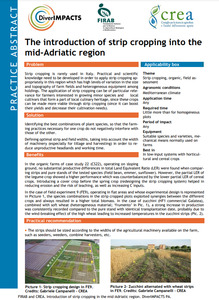{Tool} The introduction of strip cropping into the mid-Adriatic region (DiverIMPACTS Practice Abstract). [L'introduzione della coltivazione a strisce nel Medio Adriatico (DiverIMPACTS Practice Abstract).] Creator(s): Colombo, Luca; Campanelli, Gabriele and Seghetti, Marco. Issuing Organisation(s): CREA - Council for Agricultural Research and Economics, FIRAB - Fondazione Italiana per la Ricerca in Agricoltura Biologica e Biodinamica. (2022)
![[thumbnail of 2022-09-15-14_06_23-Protokoll.png]](/44470/1.hassmallThumbnailVersion/2022-09-15-14_06_23-Protokoll.png)  Preview |
Image (PNG)
- Cover Image
- English
292kB |
|
PDF
- Published Version
- English
390kB | |
|
PDF
- Published Version
- Italian/Italiano
415kB |
Document available online at: https://zenodo.org/record/6322893#.YyMVK3ZByUk
Summary in the original language of the document
In the organic farms of case study 22 (CS22), operating on sloping ground, no substantial productive differences in total Land Equivalent Ratio (LER) were found when comparing strips and pure stands of the tested species (field bean, emmer, sunflower). However, the partial LER of the legume crop showed a higher performance which was counterbalanced by the lower partial LER of cereal crops. Introducing a cover crop before the spring crop (redesigning the strip cropping system) helped in reducing erosion and the risk of leaching, as well as increasing C inputs. In the case of field experiment 9 (FE9), operating in flat areas and whose experimental design is represented in Picture 1, the species combinations in the strip-cropped plots exploited synergies between the different crops and always resulted in higher total biomass. In the case of zucchini (HF1 commercial Galatea), combined with soft wheat (heterogeneous material; ‘frumento’ in Pic. 1), a strong increase in production was consistently recorded compared to the pure stand with identical transplantation date, probably due to the wind-breaking effect of the high wheat leading to increased temperatures in the zucchini strips (Pic. 2).
Summary translation
Nelle aziende biologiche del caso studio 22 (CS22), che operano su terreni in pendenza, non sono state riscontrate differenze produttive sostanziali nel rapporto totale di Land Equivalent Ratio (LER) quando si sono confrontate strisce e parcelle in purezza delle specie testate (fava, farro, girasole). Tuttavia, il LER parziale della coltura di legumi ha mostrato un rendimento superiore controbilanciato dal LER parziale inferiore delle colture di cereali. L'introduzione di una coltura di copertura prima della coltura primaverile (ridisegnando il sistema di coltivazione a strisce) ha contribuito a ridurre l'erosione e il rischio di lisciviazione, oltre ad aumentare gli apporti di carbonio al suolo. Nel caso dell'esperimento di campo 9 (FE9), che opera in aree pianeggianti e il cui disegno sperimentale è rappresentato nella figura 1, le combinazioni di specie negli appezzamenti coltivati a strisce hanno sfruttato le sinergie tra le diverse colture e hanno sempre portato a una biomassa totale più elevata. Nel caso dello zucchino (cv. Galatea commerciale HF1), combinato con il grano tenero (materiale eterogeneo; in Fig. 1), si è registrato un forte aumento della produzione rispetto alle parcelle in purezza aventi identica data di trapianto, probabilmente dovuto all'effetto frangivento del grano alto che ha portato a un utile aumento delle temperature nelle strisce di zucchini (Fig. 2).
| EPrint Type: | Practice tool |
|---|---|
| Teaser: | Get practical recommendations for the application of srtip cropping in the mid-Adriatic region. |
| What problem does the tool address?: | Strip cropping is rarely used in Italy. Practical and scientific knowledge needs to be developed in order to apply strip cropping appropriately in this region which has high levels of variation in the size and topography of farm fields and heterogeneous equipment among holdings. The application of strip cropping can be of particular relevance for farmers interested in growing minor species and local cultivars that form a part of local culinary heritage since these crops can be made more viable through strip cropping (since it can boost their yields and decrease their cultivation needs). |
| What solution does the tool offer?: | Identifying the best combinations of plant species so that the farming practices necessary for one crop do not negatively interfere with those of the other. Defining optimal strip and field widths, considering the width of machinery (especially for tillage and harvesting) to reduce unproductive headlands and working time. |
| Country: | Italy |
| Type of Practice Tool: | Practice abstracts |
| Keywords: | strip cropping, assessment |
| Agrovoc keywords: | Language Value URI English diversification http://aims.fao.org/aos/agrovoc/c_2344 English cropping systems http://aims.fao.org/aos/agrovoc/c_1971 |
| Subjects: | Crop husbandry > Crop combinations and interactions |
| Research affiliation: | European Union > Horizon 2020 > Diverimpacts Italy Italy > CREA European Union > Organic Farm Knowledge |
| Horizon Europe or H2020 Grant Agreement Number: | 727482 |
| Related Links: | https://organic-farmknowledge.org/tool/44470, https://organic-farmknowledge.org/tool/44408, https://organic-farmknowledge.org/tool/42676 |
| Project ID: | ofk |
| Deposited By: | Rüger, Madelaine Lea |
| ID Code: | 44470 |
| Deposited On: | 18 Oct 2022 07:33 |
| Last Modified: | 02 May 2024 10:31 |
| Document Language: | English, Italian/Italiano |
| Status: | Published |
Repository Staff Only: item control page

 Download Statistics
Download Statistics Download Statistics
Download Statistics
